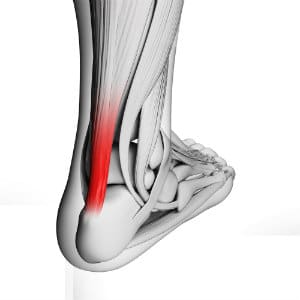Achilles Tendon Problems
The Achilles tendon is the strong band of tissue that connects the calf muscle to the heel and helps you point your foot downward and push off as you walk. If stretched beyond its capacity, the tendon can tear (rupture), causing severe pain in the ankle and lower leg that can make it difficult or impossible to walk. An Achilles tendon rupture often occurs as a result of repeated stress on the tendon and may be partial or complete, depending on the severity of the injury.
Injuries to the Achilles tendon are quite common and they can be caused by several factors, including:
- Overuse
- Poor stretching habits
- Tight or weak calf muscles
- Flat feet
- Wearing shoes that do not fit properly
- Engaging in physical activity after a long break
 After an Achilles tendon rupture, patients often experience severe Achilles tendon pain and swelling and are unable to walk normally. You may hear a popping or snapping sound as the rupture occurs. Many people will state that they fell like they got “hit with a bat in the back of their ankle or calf”. The symptoms are similar to those of other conditions, such as bursitis and tendonitis, so it is important to seek prompt medical attention to determine the correct diagnosis of your condition.
After an Achilles tendon rupture, patients often experience severe Achilles tendon pain and swelling and are unable to walk normally. You may hear a popping or snapping sound as the rupture occurs. Many people will state that they fell like they got “hit with a bat in the back of their ankle or calf”. The symptoms are similar to those of other conditions, such as bursitis and tendonitis, so it is important to seek prompt medical attention to determine the correct diagnosis of your condition.
Treatment for an Achilles tendon rupture depends on the severity of the condition. Nonsurgical treatment is reserved for the mildest of cases or for patients who lead a sedentary life. Those cases may only require a cast or walking boot for several weeks, although the risk of a recurring rupture is higher. Patients can help prevent an Achilles tendon injury by stretching the tendon and nearby muscles before participating in physical activity.
Most Achilles tendon injuries require surgery to reattach the tendon and allow the patient to resume normal foot function. Surgery often increases the patient’s push-off strength and improves muscle function and movement of the ankle. Until surgery is performed, patients will likely suffer from recurring tears.
 Various surgery techniques are available to repair a ruptured Achilles tendon. Following surgery, the foot and ankle are initially placed into a splint and then transitioned into a cast or a walking boot. The surgeon will determine when the patient can begin weight-bearing depending on the severity of the rupture.
Various surgery techniques are available to repair a ruptured Achilles tendon. Following surgery, the foot and ankle are initially placed into a splint and then transitioned into a cast or a walking boot. The surgeon will determine when the patient can begin weight-bearing depending on the severity of the rupture.
Whether an Achilles tendon rupture is treated surgically or non-operatively, physical therapy is an important component of the healing process. Physical therapy involves exercises that strengthen the muscles and improve the range of motion of the foot and ankle.
Chronic Rupture of Achilles
When an Achilles tendon rupture is not repaired, it can become a chronic problem. The tears keep recurring upon any use of the foot, so even the mildest form of activity such as walking can produce pain and inflammation.
Once an Achilles tendon injury has become chronic, it generally requires surgery to reattach the tendon and allow the patient to resume normal foot function. Until surgery is performed, patients will likely continue to suffer from persistent discomfort.
During the Achilles tendon repair procedure, an incision is made along the back of the ankle to access the tendon. The torn ends are then reattached using strong sutures that are placed on both ends. The sutures are tied together and the incision is then closed.
After surgery, patients will need to undergo six to eight weeks of physical therapy while the foot heals in a walking boot or cast. The foot may be positioned differently within the cast as healing progresses to maximize movement.
Achilles Tendinosis (Degenerative Tendinopathy)
Achilles tendinosis is a condition in which very small tears form and inflammation occurs in the Achilles tendon. Otherwise known as degenerative tendinopathy, this disorder frequently affects athletes and happens when too much stress is placed on the tendon. Achilles tendinosis is usually a painful but short-lived condition.
Achilles tendinosis may occur as a result of improper technique, overuse, flattening the arch of the foot or trauma. As this stress occurs, symptoms may begin to appear gradually.
Symptoms of Achilles tendinosis include:
- Dull pain while walking
- Tenderness
- Stiffness
- Swelling
- Soreness
Achilles tendinosis increases your risk of rupturing your Achilles tendon, a condition that requires immediate attention. A ruptured tendon will cause sudden, severe pain and swelling and difficulty walking. Your doctor can diagnose Achilles tendinosis through a physical examination and imaging test.
If you are suffering from Achilles tendon pain, you may be able to treat the condition at home through rest, ice and over-the-counter pain medication. If these methods are ineffective, your doctor may recommend orthotics, a walking boot, crutches or surgery. Surgery removes the inflamed tissue in the area.
Insertional Achilles Tendinitis
Insertional Achilles tendinitis occurs when the normal wear and tear of activity has caused degeneration of the tendon in the spot where it connects to the heel bone. It can cause inflammation and pain in the heel area. Bone spurs may develop and the damaged tissue of the tendon can begin to harden as well.
Insertional Achilles tendinitis may be treatable with rest, ice and over-the-counter pain medication. In more severe cases, your doctor may recommend orthotics, a walking boot, crutches or surgery to remove the inflamed tissue.
Contact Us
Ladera Ranch
333 Corporate Dr. Ste 230, Ladera Ranch, CA 92694
Tel: (949) 364-9255 (WALK)
Fax: (949) 364-9250
Office Hours:
Monday - Friday: 9am - 5pm
*(Lunch 12 noon - 1pm)
Orange
2617 E Chapman Ave. Ste 303, Orange, CA 92869
Tel: (714) 639-7993
Fax: (714) 639-0729
Office Hours:
Monday - Friday: 9am - 5pm
*(Lunch 12 noon - 1pm)
